Fast charging Hyundai Ioniq Electric 2017 Owner's Manual
[x] Cancel search | Manufacturer: HYUNDAI, Model Year: 2017, Model line: Ioniq Electric, Model: Hyundai Ioniq Electric 2017Pages: 582, PDF Size: 37.73 MB
Page 8 of 582
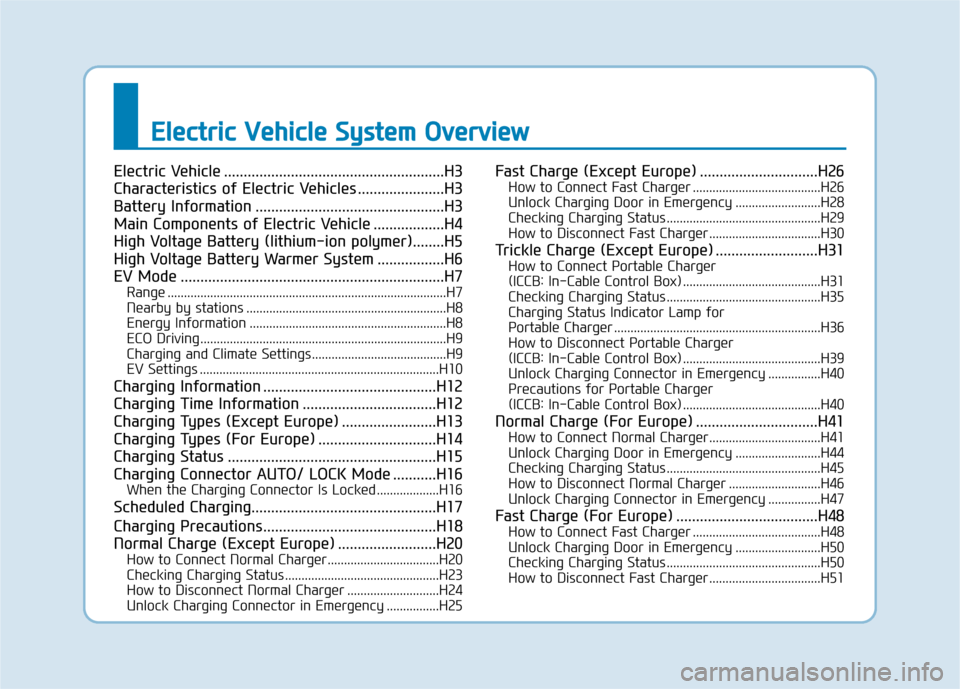
EEllee ccttrr iicc VV eehh iicc llee SS yyssttee mm OO vvee rrvv iiee ww
Electric Vehicle ........................................................H3
Characteristics of Electric Vehicles ......................H3
Battery Information ................................................H3
Main Components of Electric Vehicle ..................H4
High Voltage Battery (lithium-ion polymer)........H5
High Voltage Battery Warmer System .................H6
EV Mode ...................................................................H7
Range .....................................................................................H7
Nearby by stations .............................................................H8
Energy Information ............................................................H8
ECO Driving ...........................................................................H9
Charging and Climate Settings.........................................H9
EV Settings .........................................................................H10
Charging Information ............................................H12
Charging Time Information ..................................H12
Charging Types (Except Europe) ........................H13
Charging Types (For Europe) ..............................H14
Charging Status .....................................................H15
Charging Connector AUTO/ LOCK Mode ...........H16 When the Charging Connector Is Locked ...................H16
Scheduled Charging...............................................H17
Charging Precautions............................................H18
Normal Charge (Except Europe) .........................H20 How to Connect Normal Charger..................................H20
Checking Charging Status ...............................................H23
How to Disconnect Normal Charger ............................H24
Unlock Charging Connector in Emergency ................H25 Fast Charge (Except Europe) ..............................H26
How to Connect Fast Charger .......................................H26
Unlock Charging Door in Emergency ..........................H28
Checking Charging Status ...............................................H29
How to Disconnect Fast Charger ..................................H30
Trickle Charge (Except Europe) ..........................H31 How to Connect Portable Charger
(ICCB: In-Cable Control Box) ..........................................H31Checking Charging Status ...............................................H35
Charging Status Indicator Lamp for
Portable Charger ...............................................................H36
How to Disconnect Portable Charger
(ICCB: In-Cable Control Box) ..........................................H39 Unlock Charging Connector in Emergency ................H40
Precautions for Portable Charger
(ICCB: In-Cable Control Box) ..........................................H40
Normal Charge (For Europe) ...............................H41 How to Connect Normal Charger..................................H41
Unlock Charging Door in Emergency ..........................H44
Checking Charging Status ...............................................H45
How to Disconnect Normal Charger ............................H46
Unlock Charging Connector in Emergency ................H47
Fast Charge (For Europe) ....................................H48 How to Connect Fast Charger .......................................H48
Unlock Charging Door in Emergency ..........................H50
Checking Charging Status ...............................................H50
How to Disconnect Fast Charger ..................................H51
Page 19 of 582
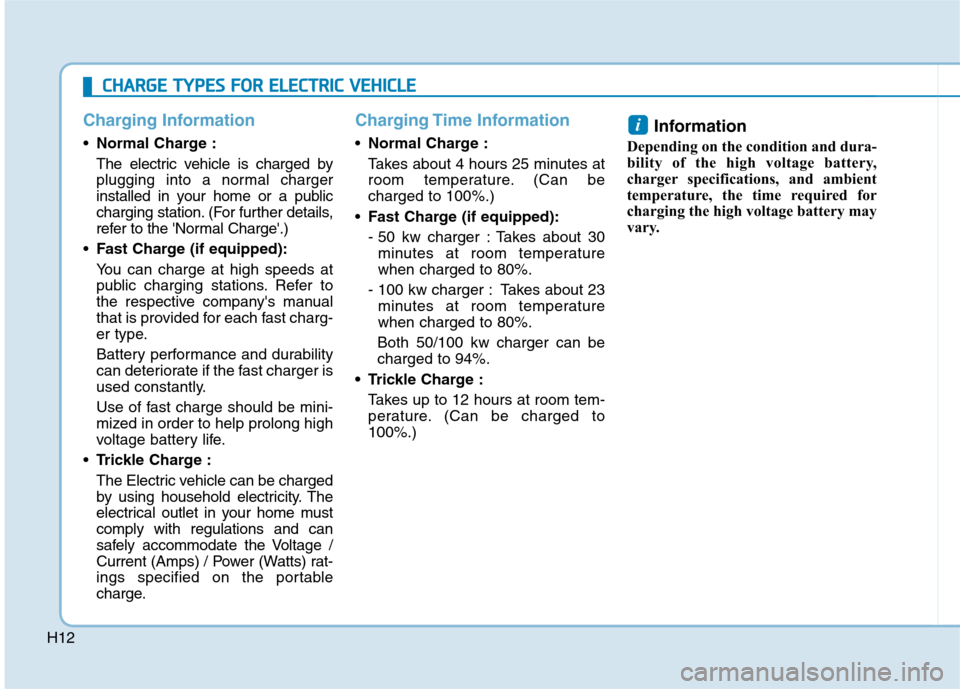
H12
Charging Information
Normal Charge :
The electric vehicle is charged by
plugging into a normal charger
installed in your home or a public
charging station. (For further details,
refer to the 'Normal Charge'.)
Fast Charge (if equipped):
You can charge at high speeds at
public charging stations. Refer to
the respective company's manual
that is provided for each fast charg-
er type.
Battery performance and durability
can deteriorate if the fast charger is
used constantly.
Use of fast charge should be mini-
mized in order to help prolong high
voltage battery life.
Trickle Charge :
The Electric vehicle can be charged
by using household electricity. The
electrical outlet in your home mustcomply with regulations and can
safely accommodate the Voltage /
Current (Amps) / Power (Watts) rat-
ings specified on the portable
charge.
Charging Time Information
Normal Charge :
Takes about 4 hours 25 minutes at
room temperature. (Can becharged to 100%.)
Fast Charge (if equipped):
- 50 kw charger : Takes about 30
minutes at room temperature when charged to 80%.
- 100 kw charger : Takes about 23 minutes at room temperaturewhen charged to 80%.
Both 50/100 kw charger can becharged to 94%.
Trickle Charge :
Takes up to 12 hours at room tem-
perature. (Can be charged to100%.) Information
Depending on the condition and dura-
bility of the high voltage battery,
charger specifications, and ambient
temperature, the time required for
charging the high voltage battery may
vary.
i
CC HH AARRGG EE TT YY PPEESS FF OO RR EE LLEE CCTT RR IICC VV EEHH IICC LLEE
Page 20 of 582
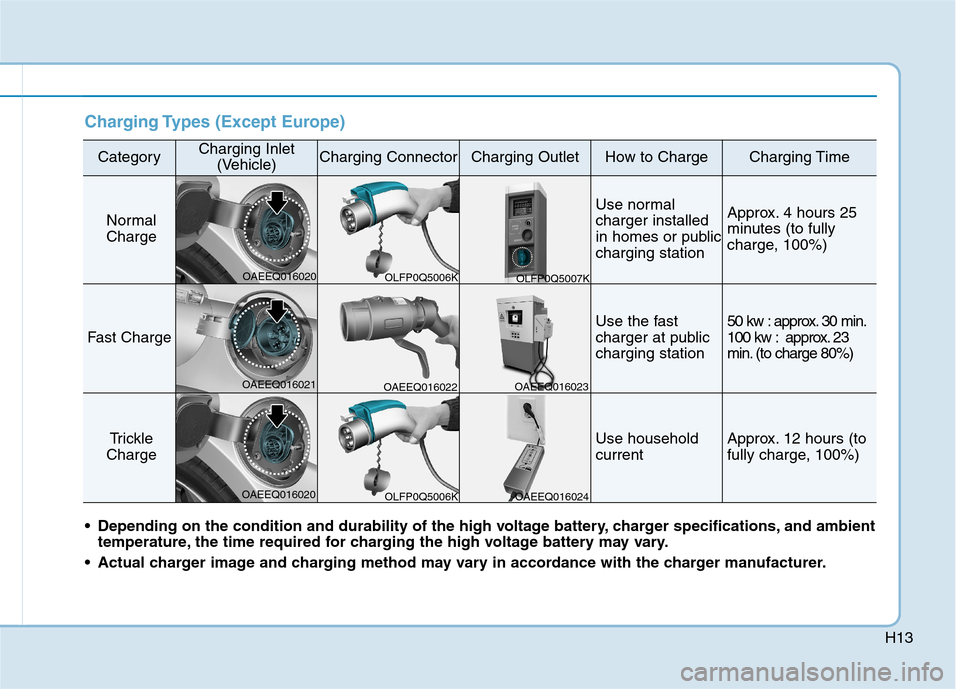
H13
Charging Types (Except Europe)
CategoryCharging Inlet(Vehicle)Charging ConnectorCharging OutletHow to ChargeCharging Time
Normal
Charge
Use normal charger installed
in homes or publiccharging stationApprox. 4 hours 25
minutes (to fully
charge, 100%)
Fast Charge
Use the fast
charger at publiccharging station50 kw : approx. 30 min.
100 kw : approx. 23
min. (to charge 80%)
Trickle
Charge Use household currentApprox. 12 hours (to
fully charge, 100%)
Depending on the condition and durability of the high voltage battery, charger specifications, and ambient temperature, the time required for charging the high voltage battery may vary.
Actual charger image and charging method may vary in accordance with the charger manufacturer. OLFP0Q5006K
OAEEQ016020
OAEEQ016021
OAEEQ016020 OAEEQ016022
OAEEQ016023
OAEEQ016024 OLFP0Q5007K
OLFP0Q5006K
Page 21 of 582
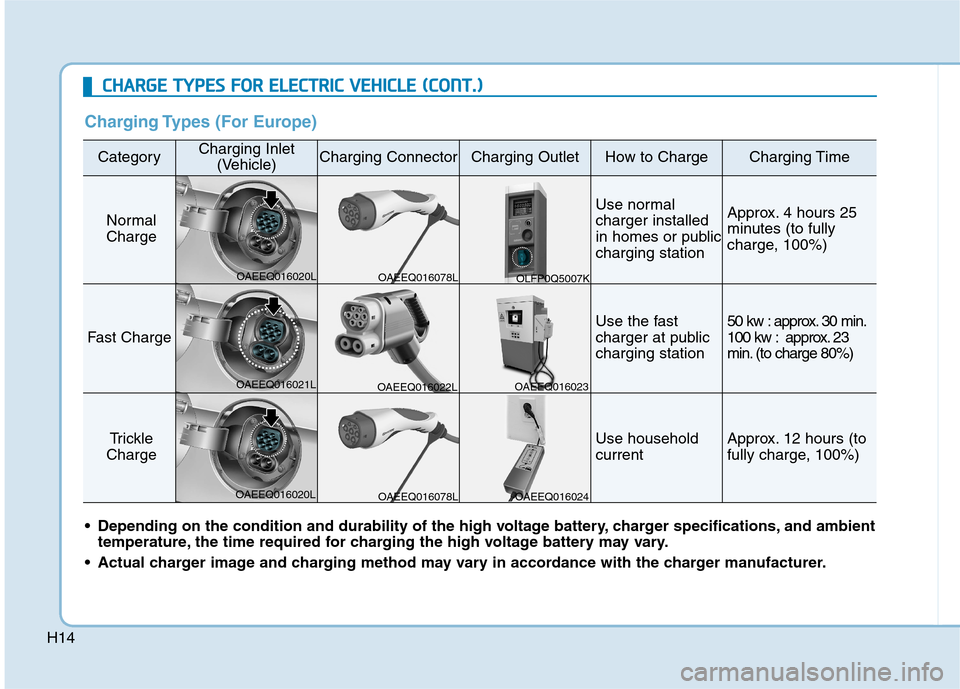
H14
Charging Types (For Europe)
CategoryCharging Inlet(Vehicle)Charging ConnectorCharging OutletHow to ChargeCharging Time
Normal
Charge
Use normal charger installed
in homes or publiccharging stationApprox. 4 hours 25
minutes (to fully
charge, 100%)
Fast Charge
Use the fast
charger at publiccharging station50 kw : approx. 30 min.
100 kw : approx. 23
min. (to charge 80%)
Trickle
Charge Use household currentApprox. 12 hours (to
fully charge, 100%)
Depending on the condition and durability of the high voltage battery, charger specifications, and ambient temperature, the time required for charging the high voltage battery may vary.
Actual charger image and charging method may vary in accordance with the charger manufacturer. OAEEQ016078L
OAEEQ016020L
OAEEQ016021L
OAEEQ016020L OAEEQ016022L
OAEEQ016023
OAEEQ016024 OLFP0Q5007K
OAEEQ016078L
CC HH AARRGG EE TT YY PPEESS FF OO RR EE LLEE CCTT RR IICC VV EEHH IICC LLEE (( CC OO NNTT..))
Page 25 of 582
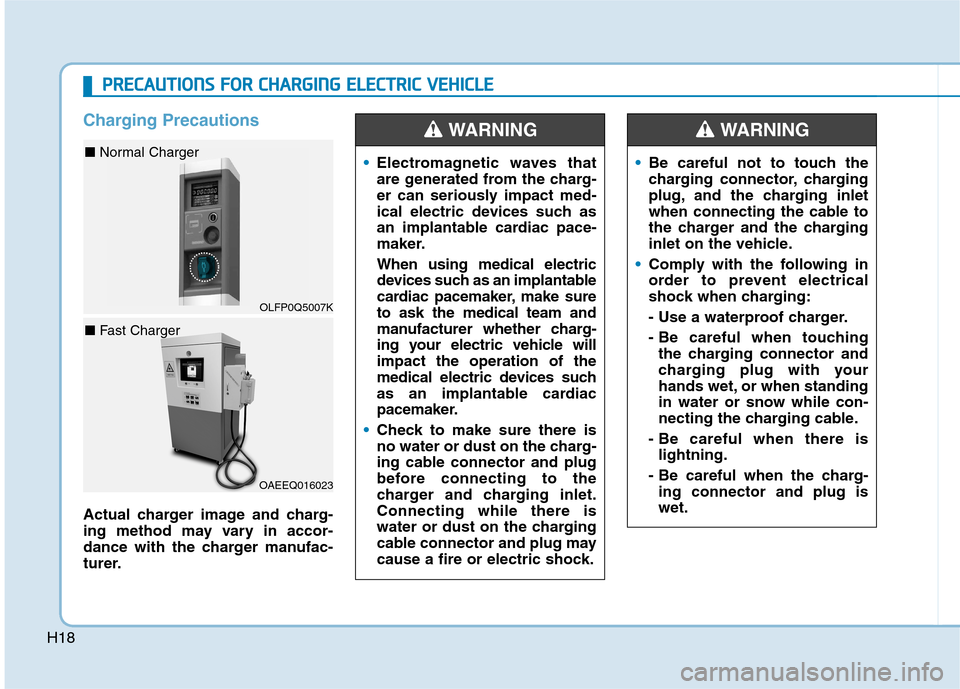
H18
Charging Precautions
Actual charger image and charg-
ing method may vary in accor-
dance with the charger manufac-
turer.
Electromagnetic waves that
are generated from the charg-
er can seriously impact med-
ical electric devices such as
an implantable cardiac pace-
maker. When using medical electric
devices such as an implantable
cardiac pacemaker, make sureto ask the medical team and
manufacturer whether charg-
ing your electric vehicle willimpact the operation of the
medical electric devices such
as an implantable cardiac
pacemaker.
Check to make sure there is
no water or dust on the charg-
ing cable connector and plug
before connecting to the
charger and charging inlet.Connecting while there is
water or dust on the charging
cable connector and plug may
cause a fire or electric shock.
WARNING
Be careful not to touch the
charging connector, charging
plug, and the charging inlet
when connecting the cable to
the charger and the charging
inlet on the vehicle.
Comply with the following in
order to prevent electrical
shock when charging:
- Use a waterproof charger.
- Be careful when touchingthe charging connector and
charging plug with your
hands wet, or when standing
in water or snow while con-
necting the charging cable.
- Be careful when there is lightning.
- Be careful when the charg- ing connector and plug iswet.
WARNING
PP RR EECCAA UU TTIIOO NNSS FF OO RR CC HH AARRGG IINN GG EE LLEE CCTT RR IICC VV EEHH IICC LLEE
OLFP0Q5007K
■
Normal Charger
OAEEQ016023
■
Fast Charger
Page 33 of 582
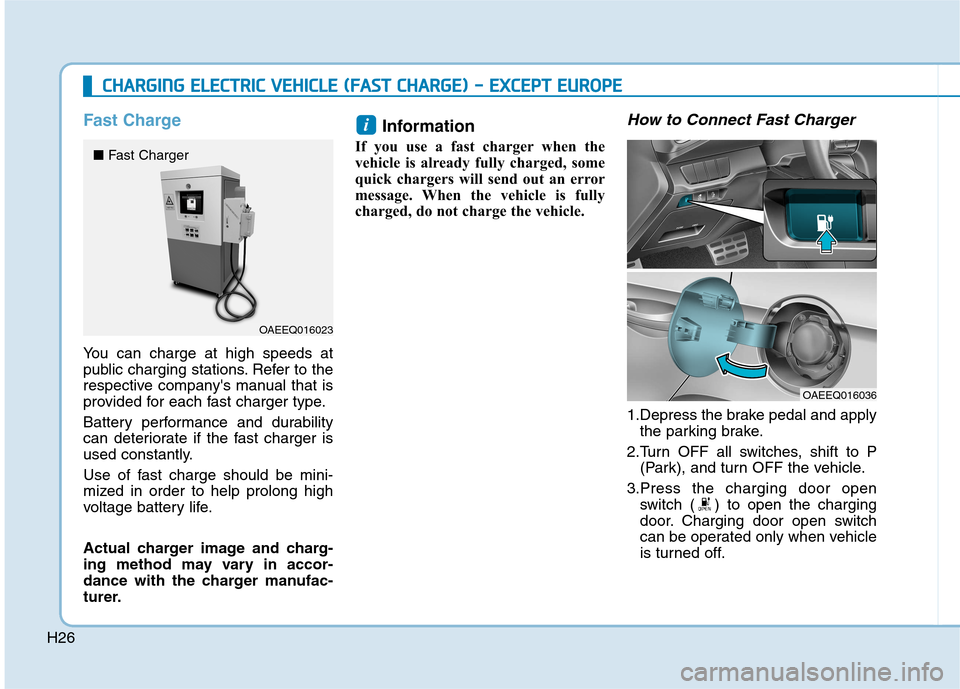
H26
Fast Charge
You can charge at high speeds at
public charging stations. Refer to the
respective company's manual that is
provided for each fast charger type.
Battery performance and durability
can deteriorate if the fast charger is
used constantly.
Use of fast charge should be mini-
mized in order to help prolong high
voltage battery life.
Actual charger image and charg-
ing method may vary in accor-
dance with the charger manufac-
turer.Information
If you use a fast charger when the
vehicle is already fully charged, some
quick chargers will send out an error
message. When the vehicle is fully
charged, do not charge the vehicle.
How to Connect Fast Charger
1.Depress the brake pedal and apply the parking brake.
2.Turn OFF all switches, shift to P (Park), and turn OFF the vehicle.
3.Press the charging door open switch ( ) to open the charging
door. Charging door open switch
can be operated only when vehicle
is turned off.
i
CCHH AARRGG IINN GG EE LLEE CCTT RR IICC VV EEHH IICC LLEE (( FF AA SSTT CC HH AARRGG EE)) -- EE XX CCEE PP TT EE UU RROO PPEE
OAEEQ016023
■
Fast Charger
OAEEQ016036
Page 34 of 582
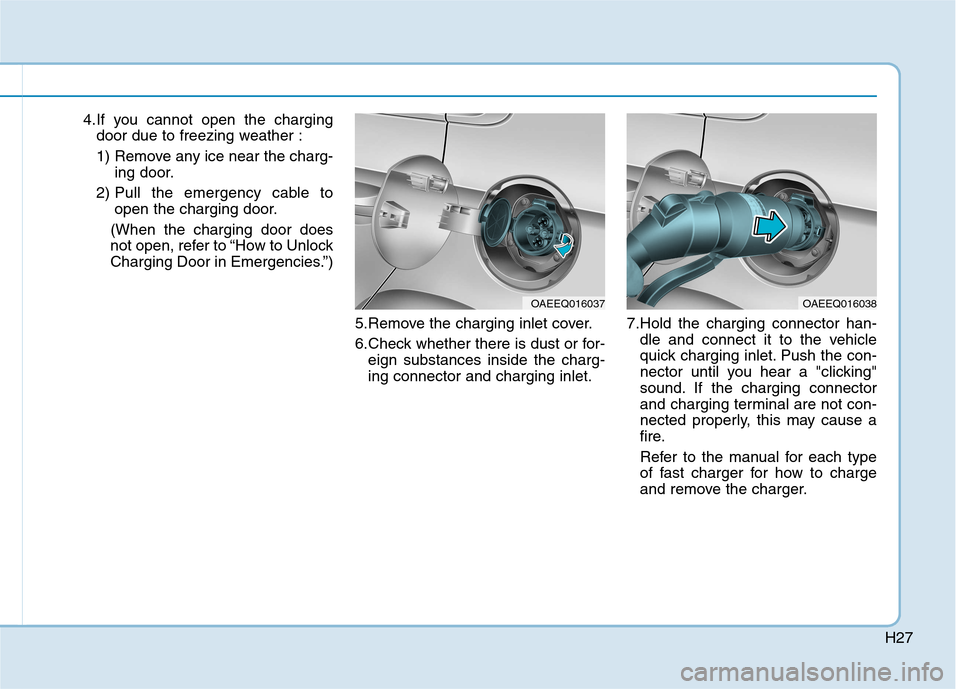
H27
4.If you cannot open the chargingdoor due to freezing weather :
1) Remove any ice near the charg- ing door.
2) Pull the emergency cable to open the charging door.
(When the charging door does
not open, refer to “How to Unlock
Charging Door in Emergencies.”)
5.Remove the charging inlet cover.
6.Check whether there is dust or for-eign substances inside the charg- ing connector and charging inlet. 7.Hold the charging connector han-
dle and connect it to the vehicle
quick charging inlet. Push the con-
nector until you hear a "clicking"
sound. If the charging connector
and charging terminal are not con-
nected properly, this may cause a
fire.
Refer to the manual for each type
of fast charger for how to charge
and remove the charger.
OAEEQ016037OAEEQ016038
Page 35 of 582
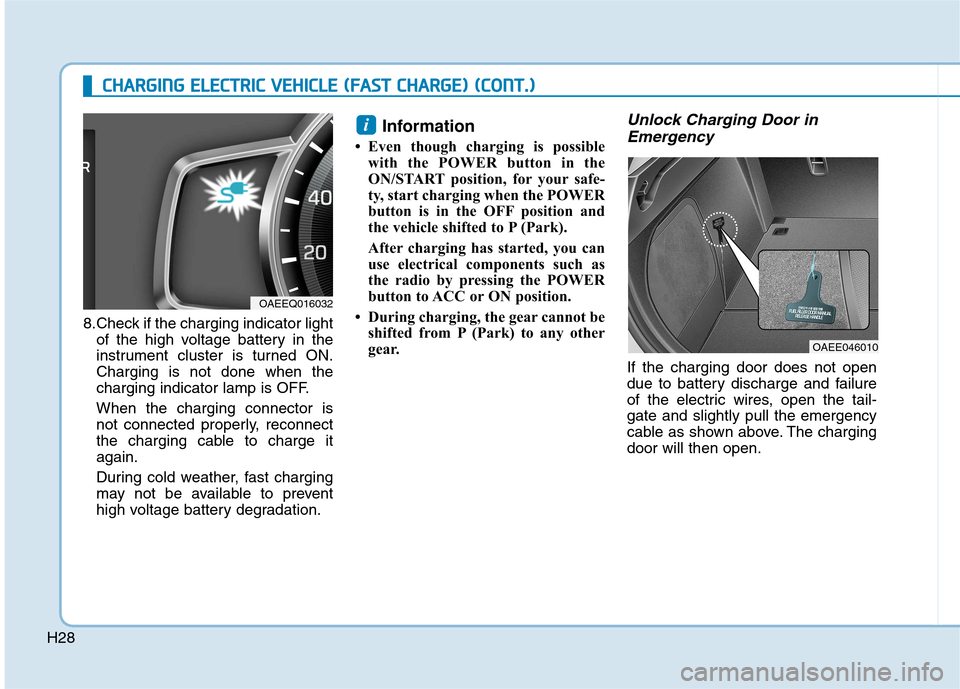
H288.Check if the charging indicator light
of the high voltage battery in the
instrument cluster is turned ON.Charging is not done when the
charging indicator lamp is OFF. When the charging connector is
not connected properly, reconnect
the charging cable to charge itagain.
During cold weather, fast charging
may not be available to prevent
high voltage battery degradation. Information
Even though charging is possible with the POWER button in the
ON/START position, for your safe-
ty, start charging when the POWER
button is in the OFF position and
the vehicle shifted to P (Park).
After charging has started, you can
use electrical components such as
the radio by pressing the POWER
button to ACC or ON position.
During charging, the gear cannot be shifted from P (Park) to any other
gear.
Unlock Charging Door in
Emergency
If the charging door does not open
due to battery discharge and failure
of the electric wires, open the tail-gate and slightly pull the emergency
cable as shown above. The chargingdoor will then open.
i
CC HH AARRGG IINN GG EE LLEE CCTT RR IICC VV EEHH IICC LLEE (( FF AA SSTT CC HH AARRGG EE)) (( CC OO NNTT..))
OAEE046010
OAEEQ016032
Page 37 of 582
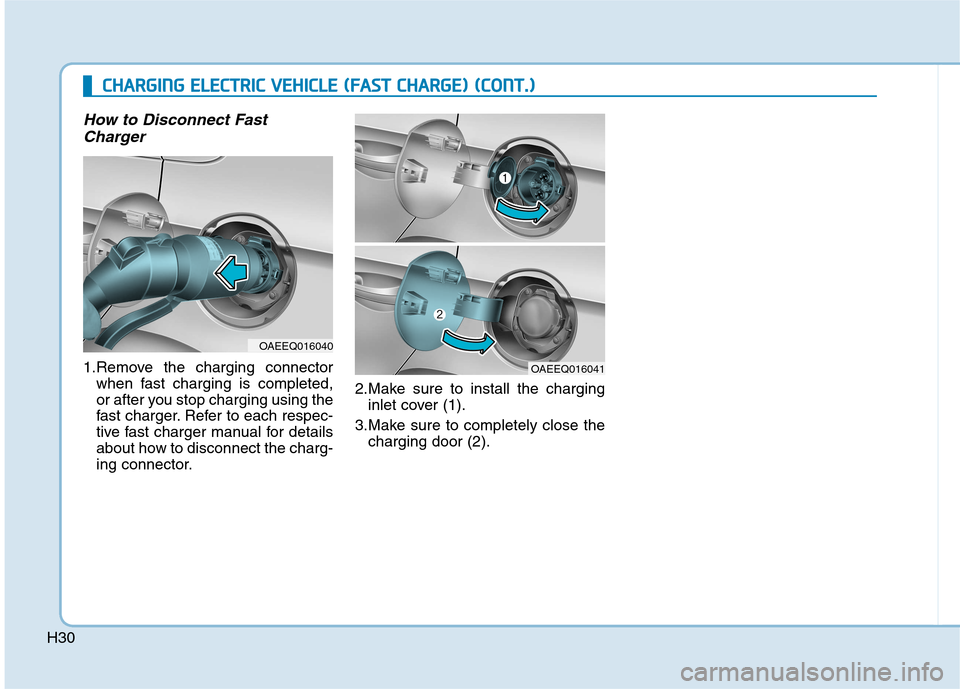
H30
How to Disconnect FastCharger
1.Remove the charging connector when fast charging is completed,
or after you stop charging using the
fast charger. Refer to each respec-
tive fast charger manual for details
about how to disconnect the charg-
ing connector. 2.Make sure to install the charging
inlet cover (1).
3.Make sure to completely close the charging door (2).
OAEEQ016040
OAEEQ016041
CCHH AARRGG IINN GG EE LLEE CCTT RR IICC VV EEHH IICC LLEE (( FF AA SSTT CC HH AARRGG EE)) (( CC OO NNTT..))
Page 38 of 582
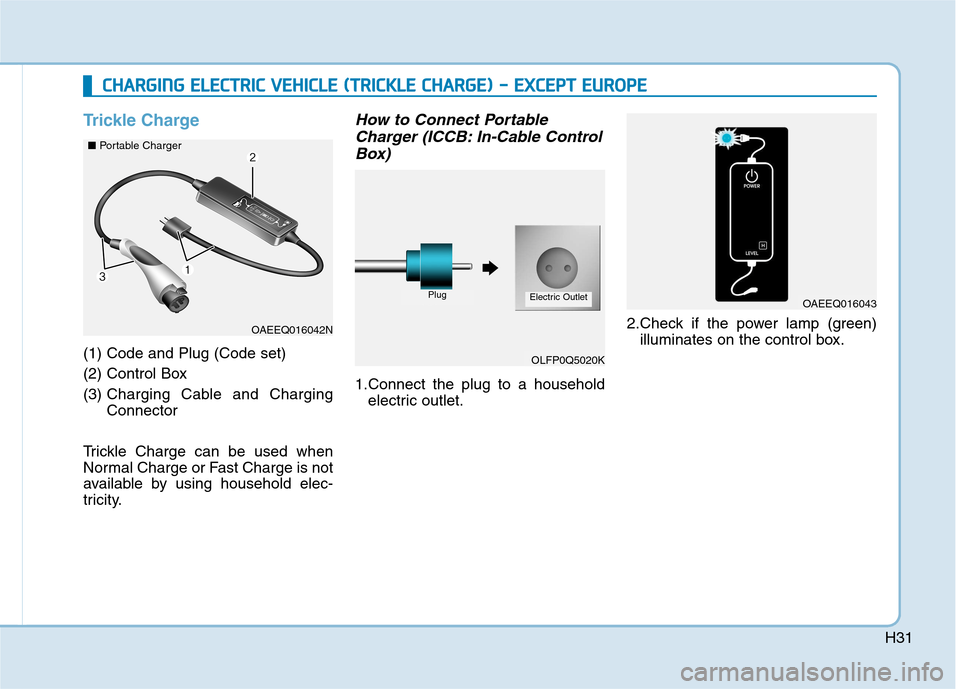
H31
Trickle Charge
(1) Code and Plug (Code set)
(2) Control Box(3) Charging Cable and Charging Connector
Trickle Charge can be used when
Normal Charge or Fast Charge is not
available by using household elec-
tricity.
How to Connect Portable Charger (ICCB: In-Cable Control Box)
1.Connect the plug to a household electric outlet. 2.Check if the power lamp (green)
illuminates on the control box.
CCHH AARRGG IINN GG EE LLEE CCTT RR IICC VV EEHH IICC LLEE (( TT RR IICC KK LLEE CC HH AARRGG EE)) -- EE XX CCEE PP TT EE UU RROO PPEE
OAEEQ016042N
OLFP0Q5020K
PlugElectric OutletOAEEQ016043
■
Portable Charger